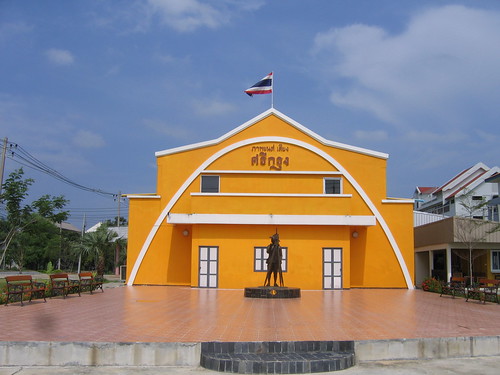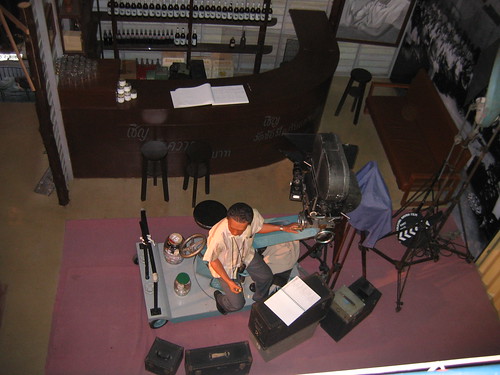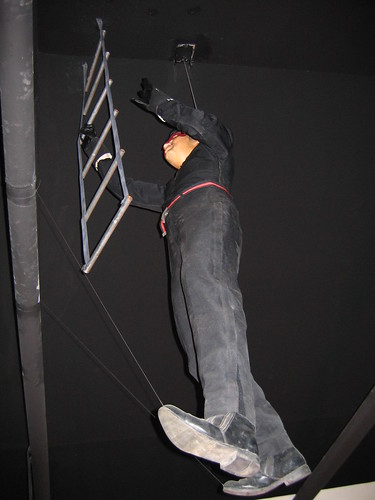
[Note: This is another in a series about Ratana Pestonji, in commemoration of the centennial of the pioneering Thai filmmaker's birth.]
A few weeks ago, I visited the National Film Archive in Salaya, Nakhon Pathom. The visit was primarily a meet-up with another Bangkok blogger, Rikker of Thai 101, who is a freqent commentator here. But it turned into something more.
The following is a story I wrote about the visit for the Daily Xpress. It was printed in today's paper, though the paper's website appears to be having some trouble, and I can't find the article online.
Like Thai cinema history itself, the museum dedicated to chronicling it is unfinished. But there are still a lot of amazing things to see. At the National Film Archive and Museum in Nakhon Pathom, Thailand’s cinematic history unspools just inside.
In all its nooks and crannies, this labyrinthine little museum is packed with props that bring forgotten films to life. There’s a steel bar that was wielded in 1963’s Singh vs Singh, the only time the era’s two top action heroes Mitr Chaibancha and Sombat Metanee met on screen.
A wax figure of Mitr as masked crime fighter Insee Daeng (Red Eagle) hangs from a ladder – a reference to the star’s death in 1970 when he was doing a helicopter stunt for his last film, Insee Thong (Golden Eagle.
There’s a house from the set of Nonzee Nimibutr’s Nang Nak, as well as the bone from the movie ghost’s forehead – not real bone from a “real” ghost. Still, it’s kind of spooky. Volunteer guide Chalida Uabumrungjit says the museum hopes someday to have a wax figure of Mae Nak’s ghost, stretching her arms from the house down to the ground.
Just like in the movie
The museum’s centrepiece is a recreation of the set from Country Hotel, a 1957 musical comedy directed by Ratana Pestonji, the Bangkok-born son of a family of Parsi-Indian merchants. He pushed for many innovations in Thai cinema during his filmmaking career from the 1950s to his death in 1970. The 100th birth anniversary of this pioneering godfather of Thai contemporary cinema falls this year, with the archive planning a celebration on his May 22 birthday.
Alongside a wax figure of Ratana and his prized Mitchell camera there is a bottle-bedecked bar, poised to host arm-wrestling contests like in the movie. Visitors are asked to sign the detailed guest register. “You can make things up,” Chalida says – though perhaps stating you are an opium trader like in the movie isn’t advisable.
The next chapter
Indie filmmaker Apichatpong Weerasethakul has his own display.
“Apichatpong is one of the few directors who pays attention to his history,” says Chalida. In a glass case is the well-travelled 16mm camera he used to make his debut feature, Mysterious Object at Noon, as well as ephemera from his other films, such as Tropical Malady and Blissfully Yours.
The censored version of Apichatpong’s latest film, Syndromes and a Century, is in the building next door, but it isn’t in the archive’s cold storage – the vault is full and another is needed to house the next chapter in the history of Thai cinema.
Pestonji Day
- Ratana Pestonji’s 100th birth anniversary will be celebrated from 4pm on May 22 with a museum tour, handprinting of film stars, meeting his family, announcing other centennial events for the year and the screening of a documentary, “Signature: The Life and Work of RD Pestonji”.
- The National Film Archive and Museum is off Salaya-Nakhon Chaisri Road in Nakhon Pathom.
- Air-con bus 515 goes past the venue. Get off at Changsibmoo – the Department of Fine Arts compound. It’s about a one-hour ride from Victory Monument and costs Bt22.
- The museum is in a bright yellow building. It is modelled after the old Sri Krung studio, one of the first film production companies in Thailand.
- The museum is open on Saturday afternoons, but not always. To arrange a tour, call (02) 482 2013-5 or e-mail nfat [at] ji-net [dot] com.

Space limitations in the paper made the article shorter than I would have liked. There is so much to see in the museum. Just inside is a closet with a green door. When you open it, it reveals a number on the door, a number 6 that flips upside down - a reference to Pen-ek Ratanaruang's second film, Ruang Talok 69 or 6ixtynin9. The museum is worth another trip back. Also worth mentioning is that the museum is just one building in the compound. Behind it is a small cinema, with seating for around 120 people, where they sometimes organize special screenings.
After the tour, Rikker and I had coffee with the Thai Film Foundation's Chalida, and Khun Dome Sukwong, the director of the National Film Archive came over to join us. We had an enjoyable talk, and I'd like to thank all three of them for indulging me by speaking English -- they would have been more comfortable chatting in Thai!
Wizard-like, the bearded, long-haired Dome was a bit sweaty, having been out out in the sun on the grounds of the National Film Archive, preparing for the Pestonji Day celebrations.
Aside from preparing for an important event to honor one of the greatest directors in Thai cinema history, Dome was pre-occupied with some bureaucratic hassles. He's been trying to get the Archive raised to the level of a public organization, which would make it more independent and have to jump through fewer hoops in order to get funding. As it is now, he has to explain his needs -- a special freezer vault, 24/7 power supply, more staff and equipment to make the Archive effective -- to many levels of bureaucrats. All it takes is one official at one of the many levels to say "no", just because they don't understand, but don't want to lose face by admitting they don't understand. It's hard to make the government higher-ups see the importance of it -- building a freezer for film isn't as compelling to them as say, erecting a statue, building a new bridge or railway line. Besides, film is just entertainment anyway, so who cares? Right?
Ironically, for all the blows the post-Thaksin military government and its National Legislative Assembly dealt filmmakers with the new film act and forthcoming ratings system, it had forwarded a measure to make the National Film Archive a public organization to the Palace. But when the government of Samak Sundaravej was elected, all those measures awaiting Palace approval were sent back. Seems the new government is having a look at the public organization law. Perhaps if some filmmakers or film-friendly folks with political influence could appeal directly to the prime minister, the way might be smoothed for the National Film Archive?
Having now visited the National Film Archive and seen the work they are doing, I'm absolutely convinced it is important. After all, if it hadn't been for them, I wouldn't have been able to see the films of Ratana Pestonji, or have gained a greater understanding of Thai cinema history and its place in Thai culture.
See also:
(Photos from the Thai Film Journal Flickrstream)



No comments:
Post a Comment
Please, no questions or comments about where to download movies or subtitle files.
Please read the FAQ about Thai films on DVD before asking about where to find a Thai movie on DVD with English subtitles.
Make your comments pertinent to the post you are commenting on. For off-topic comments, general observations or news tips, consider sending an e-mail to me at wisekwai [ a t ] g m a i l [d o t ] c o m.
All comments are moderated. Spam comments will be deleted.